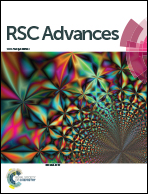K2S2O8/I2 promoted syntheses of α-thio-β-dicarbonyl compounds via oxidative C–S coupling reactions under transition metal-free and solvent-free conditions†
Abstract
A K2S2O8/I2 promoted C–S coupling reaction of β-diketones with disulfides has been described. The resulting α-thio-β-diketone compounds were obtained in good to excellent yields. Both diaryl and dialkyl disulfides coupled well with a variety of β-diketones under transition metal-free and solvent-free conditions.


 Please wait while we load your content...
Please wait while we load your content...